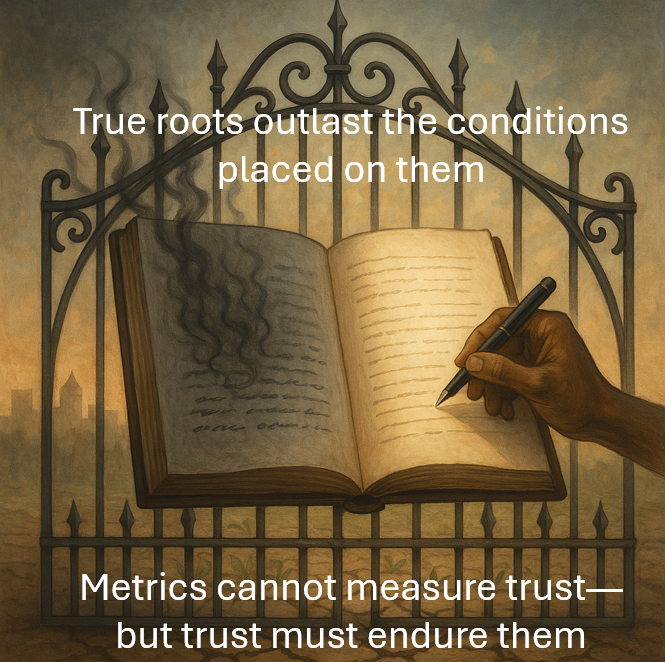
The chamber felt colder than before. Fluorescents hummed; microphones blinked red like watchful eyes. Emil stood with the Circle—Priya, Aisha, Jaden, and Mina—facing the long dais. Behind them, a few East Riverton students sat in hoodies, arms crossed but present. Photos of the mural and transcripts from the quiet box lay stacked in tidy packets. Priya’s thumb rested on the ledger’s spine.
Councilor Reyes cleared her throat. “We’ve reviewed your pilot. You were sent to the hardest soil. You returned with… sprouts.” She paused, weighing the word. “You report ten entries the first day, forty-two by week’s end, including three that led to actionable meetings with school staff and two with precinct liaisons. The mural remains unvandalized—remarkable, given the location.”
Hargrove’s pen ticked against his pad. “But outcomes aren’t proof. Anecdotes don’t scale. Who maintains this once the novelty fades? Who’s accountable when the ledger fills with anger we cannot address?”
Marco lounged in the back row, the ghost of a smile on his face.
Aisha stepped to the mic, voice steady. “Anger isn’t the problem. Silence is. We didn’t promise miracles. We promised a place to listen, then act.” She lifted a photo: TRUST? scrawled across a crack, now ringed with small signatures. “Those names? Red Jackets and Eastsiders painting together—at Crestview we saw fights drop. In East Riverton, we’ve planted the same root.”
Jaden spoke next. “We built the station with neighborhood volunteers. Scrap lumber, donated paint. Cost stays low because trust supplies labor.”
Mina set the wooden box on the table as if setting down a candle. “These are anonymized excerpts, cleared by students.” She read gently: “I just want to walk home safe.” A second: “I don’t think anyone will listen, but I’m writing anyway.” A third: “If this is real, don’t quit.”
Hargrove leaned forward. “And if this ledger becomes an outlet for false claims? For targeting?”
Priya slid a sheet forward. “Safeguards. No copies, right to retract, anonymous options, and a separate process for harm reporting. The Whisper Log rules are posted at each site.”
Reyes folded her hands. “And your request today?”
Priya met her eyes. “Expand to three more neighborhoods for one semester. Same budget structure. Train keepers locally. Publish a monthly digest of themes—no names, no raw entries. We invite oversight, but not control.”
A murmur rippled through the room. One of the East Riverton teens stood, surprising himself as much as anyone. “It ain’t perfect. But it’s the first time anyone asked us first instead of telling us.”
Silence held.
Reyes looked down the dais. “Comments?”
A councilor from North Ward spoke softly. “If they can hold East Riverton for a month without incident, pilot expansion makes sense.”
Hargrove exhaled, controlled. “Condition it on metrics. Reduction in reported incidents, cross-school participation, and a formal liaison to the city.”
Marco’s smile returned. “And if the ledger turns into performance art with no bite?”
Emil stepped forward, the basil leaf warm in his pocket. “Then prune us. But let us take root first.”
Reyes tapped her gavel once. “The motion is as follows: conditional approval for a three-neighborhood pilot—East Riverton continues, plus North Ward and Harborview. Funding limited to materials and transit. Monthly digests required, plus a midterm review. If targets are missed or safeguards breached, authorization is revoked. Vote?”
Hands lifted; lights blinked. “Motion passes, five to three.”
A breath left the Circle like air from a taut wire. Not celebration. Permission to try.
Outside the chamber, the hall smelled of dust and coffee. The East Riverton teen nudged Aisha. “You heard them—don’t quit.”
“We won’t,” Aisha said. “But you’re painting with us.”
He snorted. “Yeah. I figured.”
Marco drifted past Emil, voice low. “Congratulations—your seedlings have a fence. Be careful whose hands hold the gate.”
“We’ll build the gate,” Emil said. “And teach anyone holding it how to listen.”
Marco’s smile thinned. “We’ll see.”
Back at the greenhouse, they gathered under the south lamp. Jaden spread a city map; Mina pinned sticky notes where new stations might go. Priya drafted a template for the monthly digest; Aisha sketched a traveling mural—blank center, edges open for each neighborhood to graft its piece. Emil opened the ledger.
Ledger Entry — The Council’s Verdict
Date: October 20
Symptom: Conditional approval granted: three-neighborhood pilot, monthly digests, midterm review. Support shadowed by oversight and doubt.
Disease — The Four Absences (Institutional):
-
Absence 1 (Exclusion): Trust measured only by metrics, not by lived repair.
-
Absence 2 (Vengeance): Threat of revocation used as leverage, punishing risk-taking.
-
Absence 3 (Dehumanization): Youth framed as performers, not partners; neighborhoods as problems, not people.
-
Absence 4 (Unheard Cry): Quiet breakthroughs—first signatures, first “don’t quit”—lost under policy noise.
Investigator’s Response: Accept the pilot with guardrails: publish theme digests (no names), train local keepers, and keep Whisper Log protections prominent. Add a traveling mural to bind sites together. Invite oversight without surrendering the circle of fairness.
Outcome: A gate opens—narrow, watched, real. Sprouts hold in wind; new soil awaits.
Note: Verdicts can prune or protect. Roots remember which.
That night, Grandfather’s message lit Emil’s phone: “Storms do not test leaves; they test fiber. Keep your ring true.” Emil set the phone down and traced the ledger’s fresh lines. Outside, the wind pressed against the glass. Inside, the Circle kept working—measuring not height, but growth.

